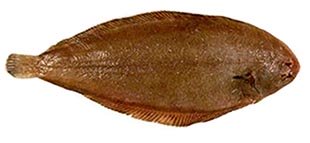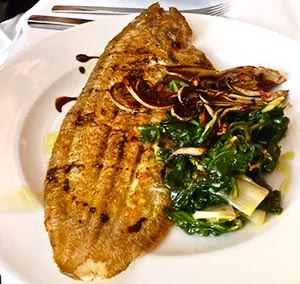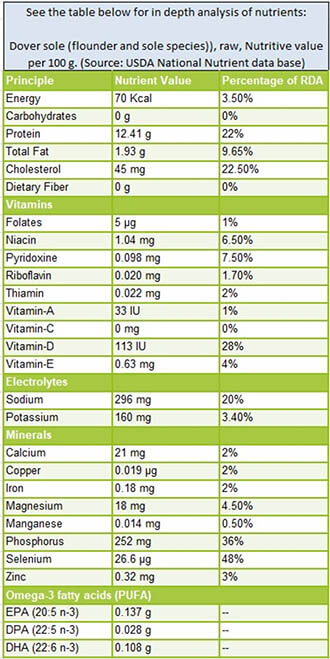Dover sole nutrition facts
Dover sole or common sole is a prized benthic flatfish found along the shallow coastal waters, stretching from the English Channel, North Sea, and the eastern Atlantic to the Mediterranean sand beds. Renowned for its fine, firm, lean white flesh and subtle sweet taste, it is a staple in French and Mediterranean cuisines.
Scientific Name: Solea solea. Dover sole belongs to the Soleidae family and is the sole true sole fish within it. Other common names for this fish include Black sole, Sole, River sole, and Slip.
 |
| European dover sole (Solea solea). |
Description
Dover sole is a type of flatfish found in temperate ocean waters. It has a long and narrow body, brown on top with dark spots and white underneath. Like halibut and other flatfish, it has eyes and a snout on its right side.
Dover (Common sole) can be recognized by a black spot on its pectoral fin and a tail that looks like a tail fin. It usually grows to be 15 to 45 centimeters long and weighs between 10 ounces and 2.5 pounds.
Pacific Dover sole (Microstomus pacificus) represents a separate species from the 'true' European sole. It features thin, less firm fillets and commands a lower price.
Senegalese sole, also known as Solea senegalensis Kaup, is similar to the common sole. Its oval-shaped body is not symmetrical and has a black membrane between its pectoral fin rays on the side with the eyes. This is different from the common sole, which has a big black spot on the back of this fin.
Lemon sole, scientifically named Microstomus kitt, has an oval body shape that is rounder than a Dover sole. Its dark side is lighter and has a yellowy-brown color.
Habitat and Biology
Dover sole is a demersal fish that exhibits almost similar growth characteristics as other benthic species like turbot, flounders, etc. Adult fish live on sandy and muddy bottoms, from the shore down to 300 m. North Sea Dover sole spawns in April-June. They feed on fish eggs, worms, small soft-shelled bivalves, small fishes, and crustaceans.
Health Benefits of Dover sole fish
Dover sole, a non-oily shallow water fish, is one of the lowest-calorie flatfish, containing just 70 calories per 100 grams, compared to 91 calories in halibut.
It serves as an excellent source of essential fatty acids, protein, minerals, and fat-soluble vitamins such as A, E, and D (cholecalciferol).
Sole fish offers lean, white meat with a favorable amino acid profile. With 12.41 grams of protein per 100 grams of fish (22% of recommended daily intake), its protein composition is complete, containing all essential amino acids in healthy proportions.
Its lean meat is rich in polyunsaturated fatty acids (PUFA), contributing to potential health benefits such as reduced risk of heart attack, stroke, obesity, and hypertension. Seafood, low in saturated fat and high in heart-healthy polyunsaturated fat, including omega-3 fatty acids, has been shown to offer protective effects.
Recognizing its low mercury levels, the US FDA categorizes Dover sole as a "best choice" seafood option, recommending 2-3 servings per week.
Black (Dover) sole provides a moderate amount of omega-3 fatty acids, including eicosapentaenoic acid (EPA), docosapentaenoic acid (DPA), and docosahexaenoic acid (DHA), which are crucial for nervous system development, particularly in infants and children.
Research from Cornell University and the New York Sea Grant Extension Program- 2012 highlights the importance of essential fatty acids in cardiovascular health, demonstrating their role in reducing blood pressure, heart rate, and the risk of arrhythmias.
In adults, studies like the "GISSI Prevention Trial have shown that daily intake of omega-3 fats can reduce the likelihood of recurrent heart attacks, strokes, or sudden death, compared to a placebo.
Although containing small amounts of Vitamin A (33 IU/100g) due to its deep water, non-oily nature, Dover sole offers moderate levels of omega-3 fatty acids such as ALA, DHA, and DPA, supporting healthy mucosa and skin.
A 100-gram serving of Dover sole fillet provides 7.5% of the recommended daily intake of pyridoxine (B-6) and 6.5% of niacin, along with significant amounts of vitamin E, vitamin B12, thiamin, and riboflavin.
Sole fillet is naturally abundant in essential minerals like iodine, calcium, zinc, potassium, phosphorus, and magnesium, with iodine being particularly vital for thyroid hormone synthesis.
Buying
Black sole is highly regarded among fish enthusiasts and remains available year-round, with peak freshness typically during the coldest months. It is harvested using bottom trawls and is commonly found fresh or frozen, either whole, top-skinned, or as skinless, boneless fillets.
When purchasing, opt for filleted fish to avoid dealing with its naturally slimy and sticky skin. Utilize the bones and head for fish stock if buying whole. Fresh preparation is recommended as sole, being non-oily, tends to dry out quickly.
Whole fish can be refrigerated for 2-3 days at 30-35 degrees Fahrenheit. Filleted products should be stored in a sealed plastic container surrounded by ice to maintain freshness.
If purchasing whole Dover sole, request your fishmonger to trim the fins as they can be quite bony.
Preparation and serving methods
Black sole offers a delicate, mild flavor and boasts a lean, firm texture. As a flatfish, a single sole can yield four fillets, making it a versatile choice for cooking, akin to flounder, fluke, dab, plaice, and other flatfish varieties.
Enjoy this versatile fish steamed, salt-baked, broiled, poached, or sautéed. It's important to avoid overcooking to maintain its delicate qualities.
Similar to other flounders, Dover sole is a non-oily fish. Poaching in white or red wine is an ideal cooking method, but it can also be baked, grilled, or pan-roasted. Keep cooking times brief to prevent the flesh from drying out.
Here are some serving ideas:
 |
| Dover sole meniure. Photo credit: Jay cross |
In the classic French style recipe, sole à la meunière, whole or filleted sole is pan-fried in melted, brown butter seasoned with capers, parsley, and lemon.
In simple and quick preparation, sole filets are poached in white wine and served with cooked vegetables.
For a simple and quick preparation, sole fillets are poached in white wine and served with cooked vegetables.
In a similar style, breaded fillets are pan or oven-fried in butter, known as de sole à l'Anglaise (English-style breaded sole).
In Poland, "filet de Sole Marie Walewska" features poached sole fillets draped in Mornay sauce.
Enjoy sole in dishes like cioppino (fish stew) and chowder, mixed with vegetables such as baby potatoes, sugar peas, and pea shoot tendrils.
Safety profile
Common sole sourced from the north Celtic Sea, the Bristol Channel, and the western English Channel is rated as 'Best choices' in terms of sustainability.
Dover sole contains trace amounts of methyl-mercury in its flesh. The mean mercury concentration in the Atlantic catch is less than 0.09 Parts Per Million (PPM). As per the final guidelines from the U.S. FDA regarding fish consumption for expectant and breastfeeding mothers, dover sole falls into the best choice category. Accordingly, they can safely consume 2-3 servings a week. (Medical disclaimer).
Also read ≻≻-
≻≻-Flounders nutrition facts and health benefits.
≻≻-Branzino (European sea bass) nutrition facts and health benefits.
≻≻-Halibut nutrition facts and health benefits.
≻≻- Trout fish nutrition facts and health benefits.
≻≻-Back to Seafood from Dover sole nutrition facts and health benefits.
Further reading (Links opens in new window):
Seafood guide -PDF.
Omega-3 Fatty Acids: An Essential Contribution.
